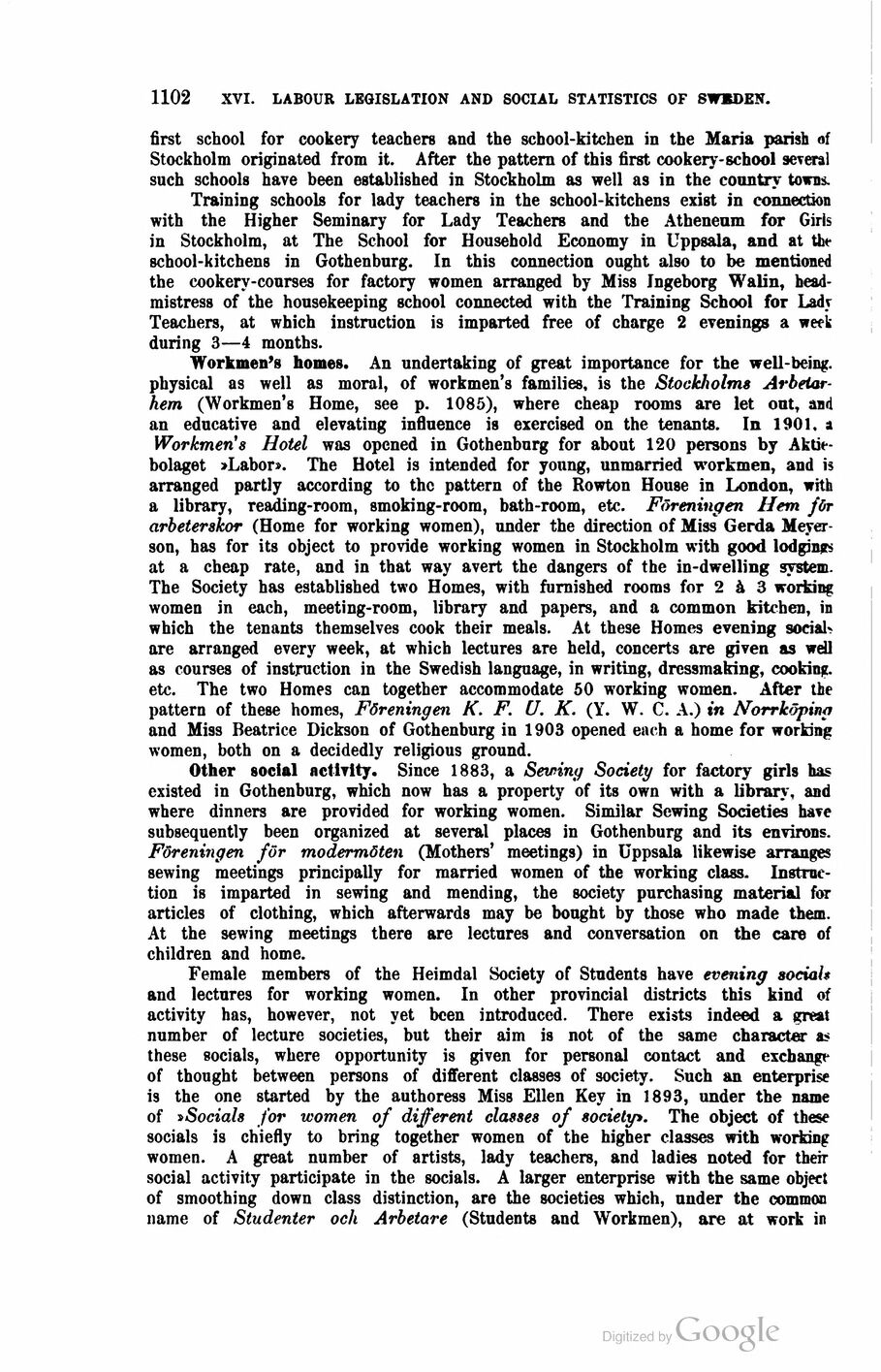
Full resolution (JPEG) - On this page / på denna sida - Second part - XVI. Labour Legislation and Social Statistics - 2. Social Condition and Social Statistics - Private Social Activity, by Miss Gerda Meyerson, Stockholm, partly after information given by Mrs. Anna Hierta-Retzius, Stockholm, and A. Ramm, City Auditor, Gothenburg

<< prev. page << föreg. sida << >> nästa sida >> next page >>
Below is the raw OCR text
from the above scanned image.
Do you see an error? Proofread the page now!
Här nedan syns maskintolkade texten från faksimilbilden ovan.
Ser du något fel? Korrekturläs sidan nu!
This page has never been proofread. / Denna sida har aldrig korrekturlästs.
1102 xvi. labour legislation and social statistics of sweden.
first school for cookery teachers and the school-kitchen in the Maria parish of
Stockholm originated from it. After the pattern of this first cookery-school several
such schools have been established in Stockholm as well as in the country towns.
Training schools for lady teachers in the school-kitchens exist in connection
with the Higher Seminary for Lady Teachers and the Atheneum for Girls
in Stockholm, at The School for Household Economy in Uppsala, and at the
school-kitchens in Gothenburg. In this connection ought also to be mentioned
the cookery-courses for factory women arranged by Miss Ingeborg Walin,
headmistress of the housekeeping school connected with the Training School for Lady
Teachers, at which instruction is imparted free of charge 2 evenings a week
during 3—4 months.
Workmen’s homes. An undertaking of great importance for the well-being,
physical as well as moral, of workmen’s families, is the Stockholms
Arbetarhem (Workmen’s Home, see p. 1085), where cheap rooms are let out, and
an educative and elevating influence is exercised on the tenants. In 1901. a
Workmen’s Hotel was opened in Gothenburg for about 120 persons by
Aktiebolaget »Labor». The Hotel is intended for young, unmarried workmen, and is
arranged partly according to the pattern of the Rowton House in London, with
a library, reading-room, smoking-room, bath-room, etc. Föreningen Hem för
arbeterskor (Home for working women), under the direction of Miss Gerda Meyer
son, has for its object to provide working women in Stockholm with good lodging
at a cheap rate, and in that way avert the dangers of the in-dwelling system.
The Society has established two Homes, with furnished rooms for 2 à 3 working
women in each, meeting-room, library and papers, and a common kitchen, in
which the tenants themselves cook their meals. At these Homes evening social*
are arranged every week, at which lectures are held, concerts are given as well
as courses of instruction in the Swedish language, in writing, dressmaking, cooking,
etc. The two Homes can together accommodate 50 working women. After the
pattern of these homes, Föreningen K. F. U. K. (Y. W. C. A.) in Norrköping
and Miss Beatrice Dickson of Gothenburg in 1903 opened each a home for working
women, both on a decidedly religious ground.
Other social activity. Since 1883, a Sewing Society for factory girls has
existed in Gothenburg, which now has a property of its own with a library, and
where dinners are provided for working women. Similar Sewing Societies have
subsequently been organized at several places in Gothenburg and its environs.
Föreningen för modermöten (Mothers’ meetings) in Uppsala likewise arranges
sewing meetings principally for married women of the working class.
Instruction is imparted in sewing and mending, the society purchasing material for
articles of clothing, which afterwards may be bought by those who made them.
At the sewing meetings there are lectures and conversation on the care of
children and home.
Female members of the Heimdal Society of Students have evening social*
and lectures for working women. In other provincial districts this kind of
activity has, however, not yet been introduced. There exists indeed a great
number of lecture societies, but their aim is not of the same character as
these socials, where opportunity is given for personal contact and exchange
of thought between persons of different classes of society. Such an enterprise
i3 the one started by the authoress Miss Ellen Key in 1893, under the name
of »Socials for women of different classes of society>. The object of these
socials is chiefly to bring together women of the higher classes with working
women. A great number of artists, lady teachers, and ladies noted for
theft-social activity participate in the socials. A larger enterprise with the same object
of smoothing down class distinction, are the societies which, under the common
name of Studenter och Arbetare (Students and Workmen), are at work in
<< prev. page << föreg. sida << >> nästa sida >> next page >>